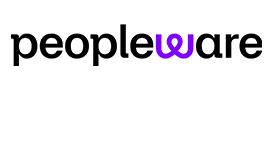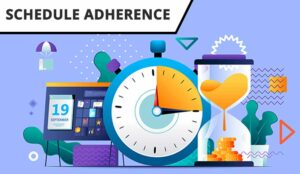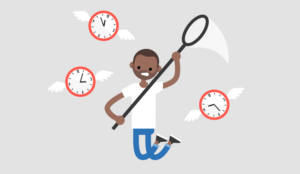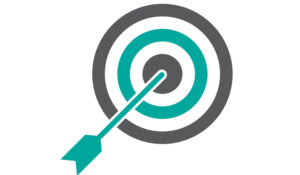Juliet Rizek of injixo discusses how to best handle adherence in the contact centre.
Let’s face it. Adherence tracking gets a bad rap. For companies that value their culture and employees, it may appear to undermine employee trust. No one wants to be “watched,” especially not the superstars on your frontline.
But is it possible to have a culture of trust and still measure schedule adherence? Yes, and here’s how.
Start With Trust
A culture of trust starts with transparency and honesty. If you are experiencing symptoms of a problem, addressing it is always a good strategy. Metrics indicative of a schedule adherence issue include:
- Not meeting your service level goals consistently
- Longer average speed of answer (ASA) times
- High shrinkage rates
- Unhealthy occupancy rates
Not measuring adherence may be the underlying problem. And, there’s an aphorism that applies: “Absence of evidence is not evidence of absence.”
You may choose not to collect data about adherence or collect it inconsistently. But your lack of diligence does not change the facts. There may be misalignments between scheduled activities and what your employees are actually working on.
There are so many good reasons why employees do not follow their schedules, but misalignments hurt your planning. As a planner, you forecast your workloads based on customer demand.
Your forecast is then used to create optimal schedules to meet that demand. But the difference between the plan and reality is people. You cannot meet your customer demand without employees.
Get Buy-In From Your Employees
Before you start measuring adherence, communication is key. Let’s start with your most valuable people: frontline staff.
Your employees don’t want to work in an environment where they are too busy or not busy enough. Boredom and stress are no fun. At the end of the day, bad schedules affect frontline employees most. To ensure their happiness, employees need balance.
Build Trust
One way to gain acceptance from your frontline team is to build trust. First, be transparent about the fact that you will be measuring adherence. Explain your goals and how you’ll use their data. Then, communicate how your goals will help them, too.
Focus on Common Goals
Aside from having balanced work, your employees will want to be on the right assignments. Each employee has a unique skill set. Adherence tracking is the opportunity to see if those skillsets are being put to good use.
With the right tool, you’ll see what your employees are currently doing and what they have the skills for. Matching skills to assignments is an opportunity to unleash your employees’ full potential. It can also help your employees develop the skills they want to practice. Bonus: your customers will enjoy a better quality of service.
Clear up Misconceptions and Show the Larger Picture
Your agents will likely associate an adherence program with being “monitored.” Take this opportunity to demystify what adherence is.
Adherence, often represented as a rate, measures the amount of time your employees work in alignment with their schedules. It does not measure how much time they work against their schedule. That’s conformance.
Unlike conformance, adherence is about alignment. It’s not about policing your team into working longer hours or canceling their vacations. It’s more about working effectively, so they are neither bored nor stressed out.
Creating alignment is a learning process for everyone. Here are some concrete examples:
- A planner, Erica, learns that sales activities run five minutes longer than scheduled. She adjusts this activity, so it’s longer on future schedules.
- A team leader, Sally, observes a pattern: Henry is always late in the morning. She asks him about it and learns that he has to drop his kids off at school. Together, they decide to adjust his schedule to start 30 minutes later.
- A frontline employee, Jamie, discovers that their AHT on technical calls is a little slow. Jamie asks for training or mentorship to develop the skills needed to improve.
The learning potential for your whole organization is endless. This is the big picture. And your frontline employees are fundamental to making your adherence program successful.
Motivate Through “The Power of One”
Knowing the importance of their role is very empowering for your frontline team. Each individual on your team is powerful. One employee can have a big impact on your organization’s success. To help explain this, The Call Center School founder Penny Reynolds created “The Power of One”.
“The Power of One” is a concept that explains the importance of schedule adherence to your staff. It has many examples of how important adherence is to the collective goals of a business. It also offers a way to motivate your team, so they want to contribute to improving adherence rates.
Gain Support From Your Team Leads
Team leaders are a good partner for your new adherence initiative. These employees want to motivate and engage their frontline teams. They work to ensure employees’ needs are being met. They want to develop their employees and mitigate problems before they start.
Partner With Team Leaders
You’ll need to establish a close relationship with team leaders. Why? Team leaders will be active in adherence work. They’ll be notifying you of absences, discrepancies, and misalignments in schedules.
To build a relationship, focus on their interest in measuring employee performance. You may want to start a regular performance metrics meeting. Review average handle times (AHT) and average speed of answer (ASA) with them. Team leads will appreciate seeing the results, especially if they are problematic.
Show How Adherence Reporting Works
High AHT and ASA metrics are indicators of a problem. But you and your team leads will have to dig deeper to find out why. Let this be an opportunity to demonstrate how adherence reporting works.
Share and review a sample adherence report. In this report, you’ll see service metrics, broken down by teams and individual employees. Identify the employee problems that can lead to poor results for the whole team. These problems may include:
- Excessive break taking by one or more individuals
- Longer than expected after-call work
- Workers assigned to the wrong activities
- Worker working on activities that differ from their assignments
Instead of focusing on the problems, you’ll want to focus on the coaching, mentoring, and training opportunities they represent. These “problems” are opportunities to align, lead and make an impact.
You’ll also want to point out that the faster you can mitigate problems, the better. It’s easier to nip small problems in the bud over time. It’s a lot harder to take action when it’s a big problem.
You won’t know what to do first. Plus, it’s stressful. With an adherence tool, like that of injixo, you’ll avoid the stress by resolving misalignments early.
Persuade With the Positive
Team leaders are deeply committed to motivating employees and boosting their productivity. While adherence reporting can identify problems, it can also measure positive results.
Team leaders can use adherence reports to identify talented, hard-working employees, too.
Talent and hard work can be hard to spot. But it can be measured. Team leaders can use adherence insights to give employee recognition and show appreciation. Recognizing those who are setting a good example— including those who are improving— is very motivating.
If team leaders want to take positive insights a step further, they can also create a friendly competition among members of their team. Team leads can create a leaderboard of their employees’ adherence rates for the week. This can make adherence fun.
Yes, Adherence Can Work for You
At the end of the day, adherence management can work for any company culture. Address concerns early and involve your team. You may even turn this into an opportunity to strengthen trust and acceptance. All you need is communication, collaboration, and a little fun along the way.
This blog post has been re-published by kind permission of Peopleware – View the Original Article
For more information about Peopleware - visit the Peopleware Website
Call Centre Helper is not responsible for the content of these guest blog posts. The opinions expressed in this article are those of the author, and do not necessarily reflect those of Call Centre Helper.
Author: Peopleware
Published On: 19th Jan 2021 - Last modified: 14th Jun 2024
Read more about - Guest Blogs, Penny Reynolds, Peopleware






 Peopleware is a leading workforce management (WFM) solution, trusted by over 500,000 users in 30+ countries. With smart forecasting, automated scheduling and real-time management, organizations can optimize workforce efficiency and keep work aligned with demand. From precise time tracking to flexible planning, Peopleware helps organizations boost operational efficiency and foster a more engaged, productive workforce.
Peopleware is a leading workforce management (WFM) solution, trusted by over 500,000 users in 30+ countries. With smart forecasting, automated scheduling and real-time management, organizations can optimize workforce efficiency and keep work aligned with demand. From precise time tracking to flexible planning, Peopleware helps organizations boost operational efficiency and foster a more engaged, productive workforce. 








